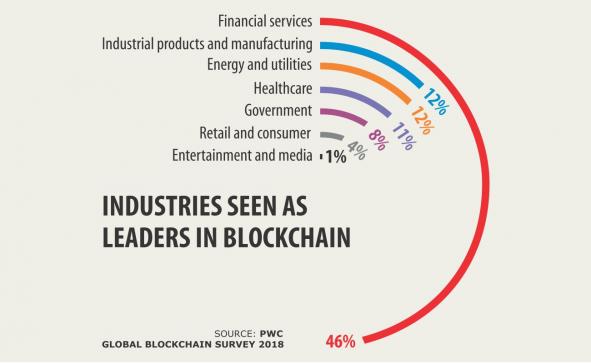Blockchain and the emergence of distributed ledger technology

Distributed ledger technology (DLT) and digital tokens are rewiring commerce worldwide. The underlying technology is blockchain.
According to a recent survey conducted by PwC globally, 84 percent of the 600 executives surveyed mentioned that their organisations have some involvement with blockchain technology.
What is the blockchain world going to look like? The survey indicated four clearly emerging trends.
First, businesses are moving fast towards tokenising everything. The digitalisation of real or virtual assets using blockchain technology is spreading to other sectors and it includes new types of assets, such as raw materials and finished goods. These new representations of digital tokens are expected to transform company processes and create new business models.
Secondly, initial coin offerings (ICOs), in which a company sells a predefined number of digital tokens to the public, are growing as an alternative to traditional capital funding.
Technology-based start-ups are raising capital for the development of such blockchain technology platforms. It should be noted that cryptocurrencies are not regularised in many economies, including Bangladesh.
However, the rapid growth in this segment in many countries is notable and it is worth deliberating whether Bangladesh should embark on a regulated cryptocurrency regime.
Thirdly, enterprise resource planning (ERP) applications have started integrating blockchain with their core systems. Many companies in Bangladesh have implemented ERPs successfully, and ERPs have become the engine for their operations (for example finance). In the coming years, their upgraded ERP versions will be blockchain enabled.
Using blockchain with their ERP systems, companies will be able to streamline processes, facilitate data sharing, and improve data integrity. It is important that companies in Bangladesh start thinking about this new technology today and build a roadmap for the future.
Finally, a good number of business leaders still perceive financial services to be the current and near-term future leader of blockchain. But other industries and services, particularly citizen services delivery, are on the rise.
Many companies in Bangladesh are now expanding internationally, with their operations' spread in multiple countries. Such companies may benefit by exploring how they use internal digital tokens to represent cash or other assets. This will help them in streamlining the movement of assets between business units across boundaries.
It will also eliminate the need for regular bank transfers, currency conversions and transaction monitoring, and will also save time and money for the businesses.
While blockchain is clearly emerging as a leading technology for the future, the rate of adoption by businesses is mixed. Among the executives surveyed by PwC, 15 percent responded that their organisations have live systems on blockchain technology.
At the same time, 7 percent stated that their blockchain projects have been paused or stopped altogether before going live. Businesses must focus on details of the design and determining the rules of engagement for successful adoption of blockchain technology.
There are several reasons that are preventing the adoption of blockchain technology at a faster rate. Building a blockchain becomes more complex when multiple stakeholders participate. In particular, companies with a presence in multiple countries and running multiple systems will encounter many issues before they can successfully adopt blockchain.
Blockchain's benefits are best realised when different industry participants come together to create a shared platform. Significant focus should be given to managing the change.
The other impediment of blockchain adoption is lack of trust. Blockchain, by its very definition, should engender trust. But in reality, companies are faced with trust issues at nearly every turn.
For one, users must build confidence in the technology itself. As with any emerging technology, challenges and doubts exist around blockchain's reliability, speed, security and scalability. And there are concerns regarding a lack of standardisation and the potential lack of interoperability with other blockchains.
Lack of clear understanding of the technology is another factor slowing down the adoption rate. A large number of executives are unclear about what blockchain really is and how it is changing different facets of business.
Blockchain's role as a two-pronged change agent—as a new form of infrastructure and as a new way to digitise assets through tokens—is not easy to comprehend and explain to the senior management within organisations.
The majority of regulators are still not comfortable with the idea of blockchain technology as a trust-building platform. Many of them have begun studying and discussing the issues, particularly as they relate to financial services.
However, it should be noted that the technology is not meant for financial services only. It has significant potential in other sectors, and regulators of those sectors should also study this technology seriously.
For example, in the telecom sector, blockchain technology can be used to solve some of the customer-centric issues, such as authenticating a customer, porting a mobile number from donor operator to recipient operator, and porting customer preferences from one operator to another operator.
The telecom regulator in India has published a consultation paper on leveraging blockchain technology to address such issues. The regulators in Bangladesh should also start studying the potential of this technology and should undertake some pilot projects to verify its viability.
With the developed world already adopting blockchain, there are quite a few use cases in Bangladesh where this new technology can be applied. As an emerging nation, Bangladesh has the advantage of starting with a clean slate and thus does not have to worry much about legacy systems.
There is ample scope for delivering citizen services using this technology, thereby catalysing inclusive growth. Also, some of the use cases for Bangladesh have the potential to become model cases for other emerging countries in the world.
